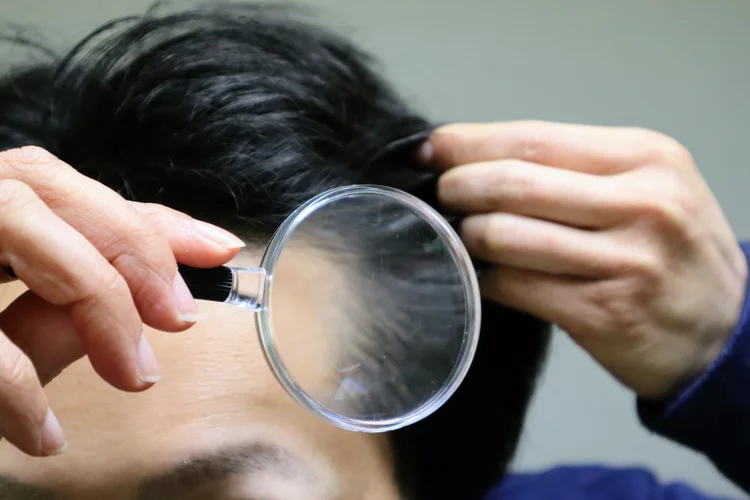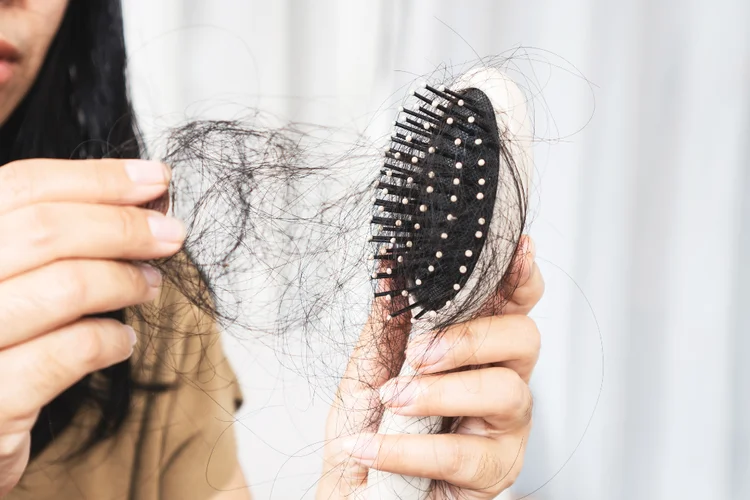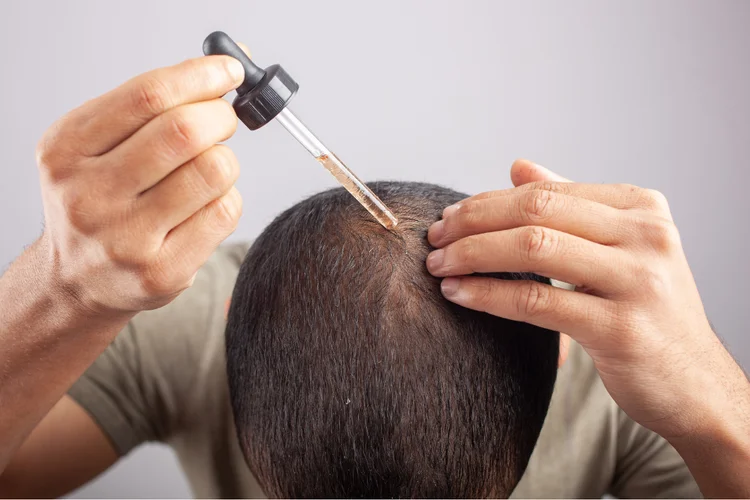Hair Loss Treatment Singapore
Losing a few strands of hair daily is normal, but if you notice significant thinning or hair
falling out in clumps, it may be a cause for concern. Whether it’s a receding hairline,
patchy bald spots, or overall thinning, hair loss can affect both men and women and may
impact confidence and self-esteem. Understanding the underlying causes of
your hair loss and exploring available treatment options can help you take proactive steps
to maintain your hair health.
What Is Hair Loss?
Hair loss happens when hair falls out faster than it regrows, leading to visible thinning or bald
patches. While losing 50 to 100 hairs a day is normal, excessive shedding or prolonged hair loss may
be a sign of an underlying issue.
Hair loss can manifest in different ways, including:
-
Gradual Thinning – A slow and progressive reduction in hair density, often
starting at the crown or parting in women and along the hairline in men.
-
Patchy Bald Spots – Small, round, or irregularly shaped bald patches that may
appear suddenly and sometimes merge into larger areas of hair loss.
-
Sudden Shedding – A noticeable increase in hair fall over a short period,
leading to widespread thinning rather than defined bald spots.
-
Full-Body Hair Loss – Hair loss that affects the scalp as well as other areas
of the body, including eyebrows, eyelashes, and body hair, often seen in individuals undergoing
chemotherapy.
Hair Loss in Singapore
Hair loss is a growing concern among Singaporeans, affecting both men and women across
different age groups. A 2022 survey on beauty found
that 44.4% of women in Singapore identified hair loss as their primary hair health concern.
Meanwhile, 63% of men were estimated to experience hair thinning or balding due to genetic
factors.
If you’re noticing increased shedding or thinning, early intervention can help slow hair
loss and improve hair health. Consult a doctor to explore suitable treatments based on your
condition.
Hair Loss Causes
Hair loss occurs when the hair growth cycle is disrupted due to genetic, hormonal, environmental, or
medical factors. Some of the most common causes include
|
Common Causes
|
Description
|
| Androgenetic Alopecia (Male & Female Pattern Hair Loss) |
A hereditary condition where hair follicles
shrink over time due to sensitivity to dihydrotestosterone
(DHT), shortening the growth phase and causing gradual thinning. Men often develop a
receding hairline and crown balding, while women experience diffuse thinning along the
parting.
|
| Telogen Effluvium |
A temporary condition where stress, illness,
pregnancy, or weight loss pushes hair follicles into the resting phase (telogen), causing
shedding. Hair usually regrows once the trigger is resolved, but shedding may last months.
|
| Alopecia Areata |
An autoimmune disorder where the
immune system mistakenly attacks hair follicles, disrupting growth and causing patchy hair
loss.
|
| Scalp Conditions |
Dandruff, psoriasis, fungal infections, or an excessively oily and itchy scalp can lead to
inflammation, weakening hair follicles and contributing to hair loss.
|
| Nutritional Deficiencies |
A lack of essential nutrients like iron and zinc can weaken hair structure, disrupt the
growth cycle, and lead to excessive shedding. Iron deficiency limits oxygen supply to hair
follicles, slowing growth. Zinc deficiency impairs follicle repair and renewal, making hair
more fragile. Biotin deficiency weakens keratin production, leading to brittle strands and
thinning.
|
| Medication Side Effects |
Some drugs, including chemotherapy, antidepressants, and blood thinners, can disrupt the hair growth
cycle. Chemotherapy targets rapidly dividing cells, including hair follicles, causing
widespread hair loss. Antidepressants and blood thinners may push hair into the shedding
phase prematurely, leading to increased hair fall.
|
What Are the Common Treatments for Hair Loss?
Treatment options for hair loss vary depending on the cause, severity, and individual
response to therapy. Commonly recommended treatments include:
1. Medications for Hair Loss
-
Minoxidil – A topical solution applied to the scalp to stimulate hair growth and slow hair
thinning. An oral form of minoxidil is also available by prescription, though it
is typically used in specific cases under medical supervision.
-
Finasteride (for men) – An oral medication that inhibits
dihydrotestosterone, the hormone responsible for male pattern baldness, helping
to slow hair loss and, in some cases, promote regrowth.
These medications are widely used and can be effective for certain types of hair loss, but
they require consistent use to maintain results. Discontinuing treatment may lead to hair
loss resuming.
2. Nutritional and Lifestyle Interventions
Eating a balanced diet that includes plenty of protein, iron, and vitamins promotes healthy hair
growth. Certain
deficiencies, such as low
iron or biotin levels, may lead to hair thinning. Avoiding harsh chemical treatments,
limiting the use of heat styling tools, and maintaining good scalp hygiene can help keep hair
follicles healthy. Managing stress through relaxation techniques or regular physical activity can
also reduce the risk of hair shedding caused by stress.
3. Low-Level Laser Therapy (LLLT)
Low-Level Laser Therapy (LLLT) is a non-invasive treatment that combats hair loss by using red or near-infrared light to stimulate hair
follicles and promote growth. The light energy is absorbed by the cells, boosting blood circulation,
reducing inflammation, and extending the hair’s natural growth phase. LLLT is often used alongside
medications like minoxidil or finasteride for better results.
4. Platelet-Rich Plasma (PRP) Therapy
Platelet-Rich Plasma (PRP) Therapy combats hair loss by delivering concentrated growth factors, which are
proteins that support cell growth and healing, to the scalp. The process involves drawing a small
amount of the patient’s blood, processing it in a centrifuge to isolate platelet-rich plasma, and
injecting it into thinning areas. These platelets release bioactive proteins that repair tissue,
strengthen follicles, and improve scalp circulation. This treatment is not approved in Singapore
currently.
5. Hair Transplant Surgery
For individuals with significant hair loss, hair transplantation can provide a long-term solution by
relocating hair follicles from a donor site, typically the back of the scalp, to thinning or bald
areas. While it can offer lasting results, success depends on factors such as donor hair
availability, individual healing response, and proper post-procedure care.
Hair Loss Treatment Price in Singapore
At ATA Medical, we offer hair loss treatment through medication and related diagnostic tests. Our
pricing is as follows:
|
Test / Treatment
|
Price*
|
| Consultation |
From $49.05 |
| Finasteride 1 mg |
$31.61 (per box of 30 tablets) |
Iron Deficiency Profile Screen
Iron, Total Iron Binding Capacity, % Iron Saturation
|
$52.32 |
Deficiency Screen
Folate, Vitamin B12, Vitamin D, Iron, Total Iron Binding Capacity, % Iron Saturation,
Ferritin
|
$161.32 |
Comprehensive Deficiency / Hair Loss Screen
Folate, Vitamin B12, Vitamin D, Iron, Total Iron Binding Capacity, % Iron Saturation,
Ferritin, Zinc, Magnesium, Free T4, TSH
|
$263.78 |
*Prices are NETT and inclusive of GST.
How to Prevent Hair Loss?
While some forms of hair loss are unavoidable due to genetics or medical conditions, certain
lifestyle and hair care habits can help maintain scalp health and slow down hair thinning.
-
Eat a Nutrient-Rich Diet – Ensure sufficient intake of protein, iron,
biotin, and omega-3 fatty acids to support strong, healthy hair.
-
Practice Gentle Hair Care – Avoid excessive heat styling, harsh
chemicals, and tight hairstyles that strain hair follicles.
-
Manage Stress – Reduce stress through exercise, meditation, and quality
sleep to help prevent stress-induced shedding.
-
Protect Your Scalp – Use sunscreen or wear a hat to shield against UV
damage, and address scalp conditions promptly.
-
Use Hair-Friendly Products – Opt for mild, sulfate-free shampoos and
minimize chemical treatments.
-
Avoid Smoking – Smoking restricts blood flow to the scalp, depriving
hair follicles of essential nutrients and potentially accelerating hair loss.
When Should You See a Doctor for Hair Loss?
You should consider seeing a
doctor if your hair loss is sudden, patchy, accompanied by scalp discomfort or other health
symptoms, or if it affects your confidence or daily life. A medical evaluation can help diagnose the
cause, address concerns, and explore treatment options. Early intervention may help slow hair loss,
promote regrowth, and manage underlying conditions effectively.
Find a Hair Loss Doctor & Clinic in Singapore
ATA Medical @ Orchard
Address: 1 Orchard Blvd, #05-09 Camden Medical Centre, Singapore 248649
Nearest MRT: Orchard Boulevard Station (TE13)
Contact Number: 6223 0682
Email: camden@atamed.sg
Opening Hours:
Mon - Fri: 8:30 AM to 12:30 PM, 1:30 PM to 5:30 PM
Sat: 8:30 AM to 12:30 PM
Sun & PH: Closed
ATA Medical @ Tanjong Pagar
Address: 72 Anson Rd, #01-02 Anson House, Singapore 079911
Nearest MRT: Tanjong Pagar Station (EW15)
Contact Number: 6223 0682
Email: hi@atamed.sg
Opening Hours:
Mon - Fri: 8:30 AM to 12:30 PM, 1:30 PM to 5:30 PM
Sat: 8:30 AM to 12:30 PM
Sun & PH: Closed
Navigate to Us
ATA Medical (Anson House)
Nearest MRT: EW15 Tanjong Pagar
ATA Medical (Camden Medical Centre)
Nearest MRT: TE13 Orchard Boulevard
Frequently Asked Questions (FAQ)
There is no single best hair loss treatment, as effectiveness depends on the
cause, severity, and how an individual responds to treatment. Common options
in Singapore include medication such as minoxidil, platelet-rich plasma
(PRP) therapy, low-level laser therapy (LLLT), and hair transplants for
advanced cases. Nutritional support and lifestyle changes may also help.
Consulting a doctor can help determine the most suitable treatment.
The most suitable hair loss treatment for women depends on the cause,
severity, and response to treatment. Common options include medication like
minoxidil, platelet-rich plasma (PRP), and low-level laser therapy (LLLT).
Addressing underlying issues such as nutritional deficiencies or hormonal
imbalances can also help. In severe cases, hair transplantation may be
considered. Consulting a doctor can help determine the most appropriate
approach.
Keratin treatments do not directly cause hair loss but may increase shedding
if excessive heat, harsh chemicals, or improper application damage the hair
and scalp. Formaldehyde-based treatments can weaken hair strands over time,
making them more prone to breakage. If hair loss occurs, it is usually
temporary. Opting for gentler formulations, proper application, and limiting
heat exposure can help maintain hair health.
Scalp treatments may support hair health by improving circulation, reducing
inflammation, and maintaining a healthy scalp environment, but they do not
directly treat conditions like androgenetic alopecia. Medicated scalp
treatments targeting dandruff, excess oil, or infections can help prevent
factors that contribute to hair loss. While beneficial as part of a holistic
approach, scalp treatments alone may not be sufficient for severe hair loss.
Managing an oily scalp can help reduce hair loss caused by clogged follicles
or scalp inflammation. Treatments may include medicated shampoos with
ingredients like salicylic acid or ketoconazole, scalp treatments to
regulate sebum production, and improving hair-washing habits. If oily scalp
hair loss is linked to conditions like seborrheic dermatitis, a doctor may
recommend specific treatments to address the underlying issue.
Scalp treatments can help maintain a healthy environment by addressing
inflammation, clogged follicles, and poor circulation, which may contribute
to hair loss. Deep cleansing, anti-dandruff therapy, and hydration masks
support follicle health. However, for genetic or medical-related hair loss,
additional treatments like minoxidil, PRP therapy, or LLLT may be more
suited to slow progression.
Yes, stress can contribute to hair loss by disrupting the hair growth cycle,
causing more hairs to enter the shedding phase prematurely. This condition,
known as telogen effluvium, is usually temporary, and hair typically regrows
once stress levels are managed. Reducing stress through relaxation
techniques, exercise, and quality sleep can support recovery. If hair loss
persists, consulting a doctor can help identify any underlying causes and
appropriate treatment.
Post-natal hair loss, or postpartum telogen effluvium, is common and usually
temporary. It occurs due to hormonal fluctuations after childbirth, causing
increased shedding. Most women experience natural regrowth within six to
twelve months. Supporting recovery with a nutrient-rich diet, gentle hair
care, and stress management can help. If hair loss is excessive or persists
beyond a year, consulting a doctor can help rule out underlying issues like
iron deficiency or thyroid imbalances.
Menopausal hair loss is linked to hormonal changes, particularly declining
oestrogen levels, which can shorten the hair growth phase and lead to
thinning. Treatments may include topical or oral minoxidil, hormone therapy
in some cases, and Platelet-Rich Plasma (PRP) therapy to support follicle
activity. Ensuring adequate intake of iron, vitamin D, and biotin may help
maintain hair health. Consulting a doctor can help determine the most
suitable approach based on your individual needs.
For mild hair loss, early intervention can help prevent progression.
Treatments may include topical or oral minoxidil and addressing nutritional
deficiencies in iron, zinc and biotin. Lifestyle changes such as reducing
heat styling, avoiding harsh chemicals, and managing stress can also help.
If hair loss continues, consulting a doctor can help identify the cause and
recommend appropriate treatment.
Some hair treatments, especially those using harsh chemicals, excessive
heat, or tight hairstyles, can weaken hair strands and lead to breakage or
thinning. Chemical relaxers, bleaching, and frequent heat styling may damage
the hair shaft over time. If hair loss worsens after a treatment, consulting
a professional can help identify the cause and recommend appropriate care to
minimise further damage.
Severe hair loss may require advanced treatments such as oral finasteride
(for men), platelet-rich plasma (PRP) therapy, or hair transplants. In cases
of alopecia areata (an autoimmune condition causing patchy hair loss),
corticosteroid injections or immunotherapy may be used. Hair transplants can
also provide a long-term solution for permanent hair loss. A doctor can
assess the severity and recommend the most suitable treatment based on the
underlying cause.
Genetic hair loss, also known as androgenetic alopecia, can be managed with
medications such as minoxidil and finasteride. Minoxidil is a topical
solution that stimulates hair follicles, while finasteride is an oral
medication that blocks dihydrotestosterone (DHT), the hormone responsible
for follicle shrinkage in men. Low-Level Laser Therapy (LLLT) and
Platelet-Rich Plasma (PRP) therapy may also support hair regrowth by
enhancing follicle activity. In advanced cases, hair transplant surgery can
be a long-term solution. Consulting a doctor or specialist can help
determine the most suitable treatment.
Losing 50 to 100 hairs per day is considered normal as part of the natural
hair growth cycle. Hair naturally sheds and regenerates in different phases,
but if hair loss becomes excessive, persistent, or leads to noticeable
thinning or bald patches, it may indicate an underlying condition such as
hormonal changes, nutritional deficiencies, or medical issues. If you are
concerned about hair loss, consulting a doctor can help identify the cause
and appropriate treatment.
A nutrient-rich diet can support hair health and reduce hair loss. Protein
from eggs, lean meats, fish, and legumes strengthens hair, while iron from
spinach, red meat, and lentils maintains follicle oxygenation. Biotin from
nuts, seeds, and sweet potatoes supports keratin production, omega-3 fatty
acids from fatty fish and flaxseeds nourish the scalp, and zinc from
shellfish and pumpkin seeds aids follicle repair.
Chronic dehydration can contribute to hair thinning by affecting scalp
hydration and follicle function. Water plays a crucial role in delivering
nutrients to hair follicles and maintaining scalp health. While dehydration
alone is unlikely to cause significant hair loss, prolonged inadequate
hydration may weaken hair strands and increase brittleness, making them more
prone to shedding. Drinking sufficient water and maintaining overall
hydration can support healthy hair growth.
Bleaching can weaken hair structure, making it more prone to breakage and
thinning, but it does not directly cause permanent hair loss. The chemicals
in bleach strip hair of its natural proteins, leading to dryness, split
ends, and brittleness. If excessive bleaching damages the scalp or burns
hair follicles, hair loss may become long-term.
There is no scientific evidence that detoxing directly causes hair loss, but
extreme detox diets or fasting can lead to nutrient deficiencies that may
trigger temporary shedding. Rapid weight loss and inadequate intake of
essential vitamins like iron, biotin, and zinc can disrupt the hair growth
cycle, resulting in telogen effluvium (temporary hair loss). A balanced diet
with adequate nutrients is essential to support healthy hair.
Hard water, which contains high levels of minerals such as calcium and
magnesium, can build up on the scalp and hair, making hair feel dry,
brittle, and more prone to breakage. While it does not directly cause hair
loss, prolonged exposure may weaken hair and contribute to scalp irritation.
Excessive alcohol consumption may contribute to hair loss by disrupting
nutrient absorption, dehydrating the scalp, and increasing oxidative stress
on hair follicles. Heavy drinking can lead to deficiencies in key nutrients
such as iron, zinc, and B vitamins, which are essential for healthy hair
growth. Moderating alcohol intake and maintaining a nutrient-rich diet can
help support hair health.
High blood pressure does not directly cause hair loss in females, but it may
contribute to reduced blood flow to the scalp, potentially affecting
follicle health. Additionally, some blood pressure medications such as
beta-blockers have been linked to temporary hair shedding. If you notice
hair thinning and suspect a connection, consult a doctor for further
evaluation.
There is no established scientific evidence linking the HPV vaccine to hair
loss. While vaccines can cause temporary side effects such as fatigue or
mild inflammation, hair loss is not a known or widely reported reaction. If
hair loss occurs after vaccination, it may be due to unrelated factors such
as stress, hormonal changes, or an underlying health condition. Consulting a
doctor can help assess potential causes of hair loss.
Iron deficiency hair loss is usually reversible with proper treatment. Since
iron is essential for transporting oxygen to hair follicles, low levels can
disrupt the hair growth cycle and lead to increased shedding. Restoring iron
levels through dietary changes or supplementation can help promote regrowth,
but it may take several months to see noticeable improvement. A doctor can
assess iron levels and recommend appropriate supplementation if needed.
Hair loss treatments can be effective, but results depend on the cause,
severity, and individual response. Medications like minoxidil and
finasteride are commonly used for androgenetic alopecia (a hereditary
condition that causes gradual hair thinning), while Platelet-Rich Plasma
(PRP) therapy and Low-Level Laser Therapy (LLLT) may help stimulate hair
follicles. Hair transplants offer a long-term solution for advanced cases.
Consulting a doctor early can help determine the most appropriate treatment.
At ATA Medical, we offer hair loss treatment through medications such as
finasteride for men, priced at $31.61 per box of 30 tablets. All prices are
NETT and inclusive of GST, excluding consultation fees.
Stopping hair fall depends on its underlying cause. Common treatments in
Singapore include medications like minoxidil and finasteride, and addressing
nutritional deficiencies. Low-Level Laser Therapy (LLLT), Platelet-Rich
Plasma (PRP) Therapy, and hair transplants may also be considered for more
severe cases. Consulting a doctor can help identify the cause and determine
the most suitable treatment.
Three common hair loss treatments include medications, Low-Level Laser
Therapy (LLLT), and hair transplant surgery. Medications like minoxidil and
finasteride help slow hair loss and promote regrowth. LLLT enhances scalp
circulation and stimulates follicle activity. For severe cases, hair
transplant surgery relocates healthy hair follicles to balding areas,
offering a long-term solution.
Hair can regrow after thinning if the hair follicles are still active.
Treatments like minoxidil, finasteride, PRP therapy, and LLLT can help
stimulate regrowth. However, in cases of advanced pattern baldness where
follicles are permanently inactive, hair transplant surgery may be the only
option. A doctor can assess whether regrowth is possible based on the cause
of thinning.
Hair loss can be caused by genetics, hormonal imbalances, stress,
nutritional deficiencies, medical conditions, medications, or scalp
disorders. Temporary shedding, such as telogen effluvium, may occur after
stress or illness, while persistent hair loss could indicate androgenetic
alopecia (hereditary hair thinning) or other underlying conditions. A
medical evaluation can help determine the cause and appropriate treatment.
A general practitioner (GP) can assess common causes of hair loss and
recommend initial treatments or diagnostic tests. For more specialised care,
a dermatologist focuses on scalp and hair disorders, while a trichologist
provides non-medical hair health advice. An endocrinologist may be consulted
if hair loss is linked to hormonal imbalances.
Yes, hair loss is common in Singapore due to genetic predisposition, stress,
environmental factors, and dietary habits. Androgenetic alopecia affects a
significant percentage of men and women, while conditions like telogen
effluvium and scalp disorders contribute to temporary or chronic hair
thinning. Seeking early treatment can help slow progression and improve hair
health.
Deficiencies in iron, biotin, and zinc are commonly linked to hair loss.
Iron supports oxygen delivery to hair follicles, biotin contributes to
keratin production, the protein that forms the structure of hair, and zinc
aids follicle repair. A well-balanced diet or supplementation may help
prevent nutrient-related hair loss. A doctor can assess deficiencies and
recommend appropriate supplementation if needed.
Permanent hair loss prevention depends on the cause. Androgenetic alopecia
can be managed with long-term use of medications like minoxidil or
finasteride, but stopping treatment may lead to recurrence. Platelet-Rich
Plasma (PRP) therapy and Low-Level Laser Therapy (LLLT) may help maintain
hair density, while hair transplant surgery offers a permanent solution for
advanced cases. A doctor can recommend the most effective approach based on
individual needs.
Emerging treatments for hair loss include oral minoxidil, which is being
explored as an alternative to topical application, and regenerative
therapies like exosome therapy, which uses stem cell-derived growth factors
to promote hair growth. Advances in hair cloning and gene therapy are also
under research. While promising, these treatments require further studies to
assess long-term effectiveness and safety.






